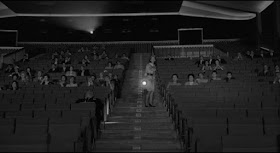 |
| Within Our Gates screen capture from Kino DVD |
As you might guess if you've read my blog over the years, many of my favorite moments of 2016 were experiences I had looking up at or, from the balcony, down at a glimmering screen with images projected upon it. I've already seen publication of lists of my favorite new features & shorts seen in 2016 (if I'd seen Toni Erdmann before the New Year rang in, it'd be on there too), and of my favorite expanded cinema performances of the year, and now it's time (or high past time, as we're already into mid-February) to focus on screenings of films from previous cinematic eras. Before I unveil my own list I'll present the favorites of more than a dozen other Frisco Bay cinephiles who I'm very pleased agreed to let me publish their selections on this blog; I call the project "I Only Have Two Eyes" because I can't possibly see every one of these wonderful repertory or revival screenings on my own, as most of them are one-off showings taking place all over the Bay Area.
This is the tenth year in a row for this annual survey. An anniversary, I guess! If you want to see the prior years' entries they're linked to in the last nine words of the first sentence of this paragraph. But keep an eye on this "hub" page as it grows over the coming days. I'm honored to have such thoughtful and perceptive participants such as:
02/09/17: John Slattery, a filmmaker based in Berkeley, clearly admires Maurice Pialat.
02/10/17: Ben Armington of BoxCubed describes his 2016 using DVD screen captures.
02/10/17: David Robson, who writes at House of Sparrows, cites Antonioni & Hitchcock showings, for starters.
02/11/17: Linda Scobie, filmmaker, programmer & projectionist, created a visual list heavy on underground film.
02/11/17: Lincoln Spector, who kindly allowed me to repost the revival entries from his Bayflicks 2016 wrap-up here.
02/12/17: Jesse Hawthorne Ficks from MiDNiTES FOR MANiACS picked a baker's dozen of showings.
02/12/17: Adam Hartzell spreads his love to the Balboa, BAMPFA, the Opera Plaza, SFSFF & YBCA.
02/13/17: Maureen Russell has a very Castro-centric list this year (with room for SFIFF & SFMOMA).
02/13/17: Claire Bain, a local artist, has chosen screenings at the Castro, Roxie & Artists' Television Access.
02/14/17: Philip Fukuda's list includes films made in eight different decades from the 1910s to the 2000s.
02/14/17: Terri Saul is a Berkeley-based artist whose selections all come from the new BAMPFA.
02/15/17: Monica Nolan, a San Francisco author & editor, has crafted a festival-heavy entry.
02/15/17: Carl Martin of the Film On Film Foundation likes typing his annual list entirely in lowercase.
02/16/17: Adrianne Finelli, a filmmaker & GAZE co-curator, highlights screenings at various cinemas- and a cave!
02/16/17: Sterling Hedgpeth blogs at The Filmatelist, where he first published his list of shows at ten different venues.
02/17/17: Lucy Laird of SFSFF and Nerd Nite SF enjoyed screenings at BAMPFA, the Castro, the Rafael & more.
02/17/17: Michael Hawley of the film-415 blog is one of two contributors who I've had the honor of publishing ten lists over the years.
02/20/17: My own list.


























